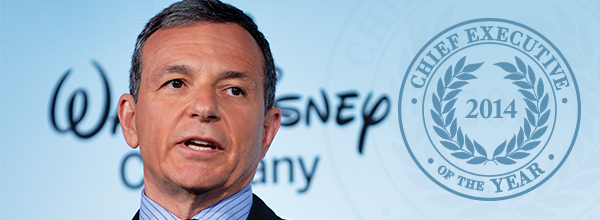CULTURE: HOW BOB IGER REMADE THE HOUSE 
CULTURE: HOW BOB IGER REMADE THE HOUSE
THAT WALT DISNEY BUILT
(Part 2 out of 4)
by J. P. Donlon
Even iconic brands need
fixing from time to time. But instead of the easy fixes, Bob Iger played the
long game by addressing Disney’s cultural issues head-on with a three-pronged
strategy, making it a stronger, more profitable company with greater depth in
its overall brand. The takeaway for CEOs is that, yes, culture—and
persistence—matter
Some industry
observers expect Iger to appoint a second-in-command before he departs. Iger
declines to comment apart from saying that his successor, “needs to be someone
who can adapt and not necessarily take the old playbook, the old rules, the old
habits or the old culture. He may need to shift focus, culture or whatever to
continue to maintain success and that great brand position that we’ve got in
the world”.
When you became CEO in 2005, you seemed to face a
triple challenge of trying to put the brand right and build revenue—but also to
fix the culture—all in the face of having to follow a well-established leader.
What did you set as your priority?
While I had very
specific and ultimately well-articulated strategic priorities for the company,
my rallying cry to the troops was that I wanted Walt Disney to be among the
most admired and respected [companies] in the world. First, I wanted Disney to
be admired and respected by the employees, “cast members,” as we call them
fondly; because if we ultimately were going to be admired and respected by our
shareholders and by our customers, it had to start at home. This also tied in
with what I wanted to do around cultural change, which I’ll come back to.
After our
employees, our investors and our consumers were also important. I created three
primary strategic priorities for the company. One: Invest most of our capital
in creating high-quality, branded content and experiences. Two: Embrace
technology and use it aggressively to enhance the quality of our product and
thus the consumer experience. To enhance what I’ll call “distribution” and thus
access to our product. And lastly, to get closer to our customer by becoming
more efficient as a company. Technology had to become a significant middle name
for the company.
In addition, the
third strategic priority was to invest much more aggressively in global growth
because we had become too U.S.-centric. Interestingly enough, I came from a
meeting with a group of folks at our company who are working on the agenda and
presentations for an upcoming Disney board of directors retreat, which we do
every June. The aim is to analyze and present to the board a strategic growth
initiative through 2025. We’re beginning with the strategic priorities of the
company, which are the same as what I created in 2005.
To what degree were you bothered by the fact that your
predecessor had made comments to the effect that you were not up to the job,
combined with press reports at the time that you were a “well-scripted CEO” but
probably not a big, strategic thinker?
I prefer not to
comment on or dwell on what any specific person said about me or believed about
me when I got the job. I will say that even though I was the only internal
candidate, and I knew the company and the board extremely well, there was a
desire by many to bring great change to the company, because we had been through
what had been a pretty difficult period. There was a feeling that any inside
candidate would essentially perpetuate the status quo. This [attitude]
motivated me because not only did I feel that I had a lot to prove, but I felt
that I had a real opportunity to be an internal change agent. Besides, I was
fairly thick-skinned at that point because I had been through a lot of that.
In hindsight, what was the most difficult challenge?
Clearly, it was
shifting the culture from a company that did not believe in itself as much as
it needed to [do], to a company that believed in itself and its future, was
optimistic about its future and respectful of its product and its leadership.
What did you have to do to make that happen?
There were a lot
of things. One of them was to redirect or disband, as the company had known it,
its strategic planning arm. I thought the individual businesses needed to own
more of their strategy, as opposed to being owned by the corporate entity. It
was important for each business to take more responsibility and accountability
for its own strategy.
Fuente: Chief Executive
Haciendo click en cada uno de los links siguientes,
accederán a los Contenidos de nuestros
TALLERES DE CAPACITACIÓN IN COMPANY A MEDIDA:
(translator on page)
¿Cómo INCORPORAR y APLICAR Modelos de
PENSAMIENTO ESTRATÉGICO?
PENSAMIENTO ESTRATÉGICO?
http://msg-latam-meic.blogspot.com.ar/2014/06/capacitacion-in-company-programa_6246.html
¿Cómo GERENCIAR EFICAZMENTE a partir del
MANAGEMENT ESTRATÉGICO?
http://msg-latam-meic.blogspot.com.ar/2014/06/capacitacion-in-company-programa_3.html
¿Cómo GERENCIAR PROCESOS DE CAMBIO
y no sufrir en el intento?
y no sufrir en el intento?
http://msg-latam-meic.blogspot.com.ar/2014/06/capacitacion-in-company-programa.html
¿Cómo IMPLEMENTAR ESTRATEGIAS EFECTIVAS?
Recetas para Escenarios Turbulentos
http://msg-latam-meic.blogspot.com.ar/2014/06/capacitacion-in-company-taller-de.html
Consultas al mail: msg.latam@gmail.com
ó al TE: +5411-3532-0510
No comments:
Post a Comment